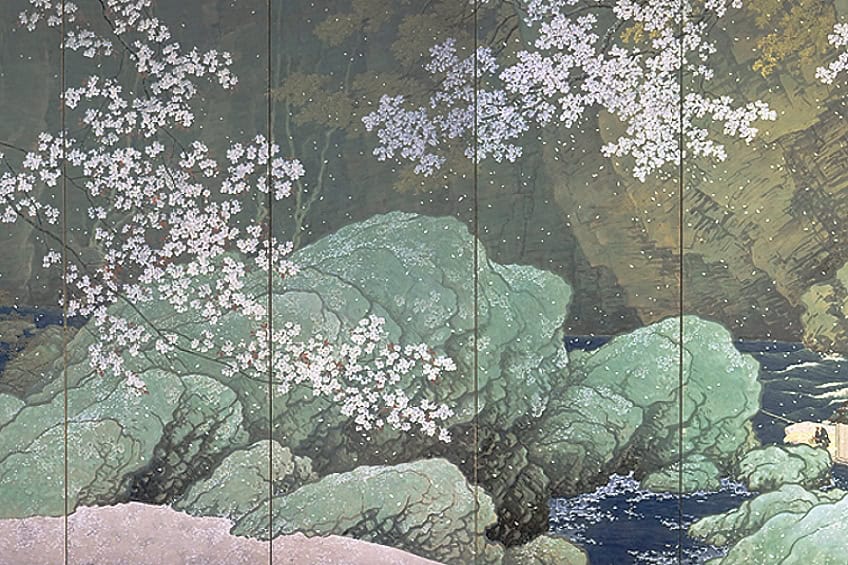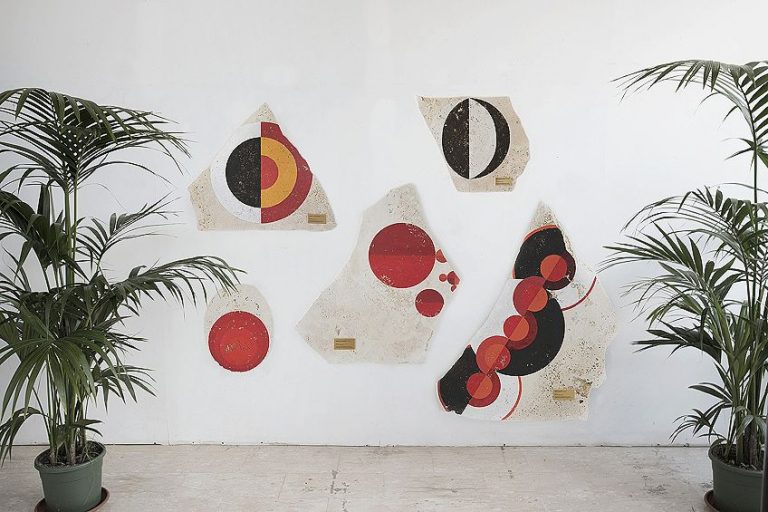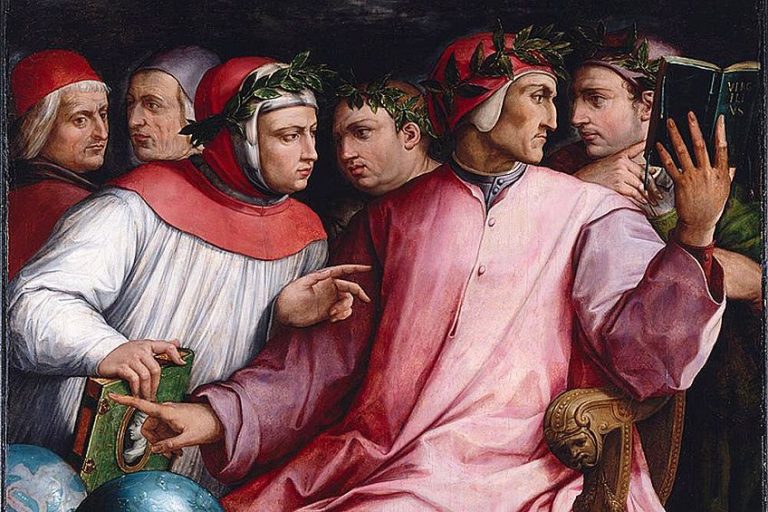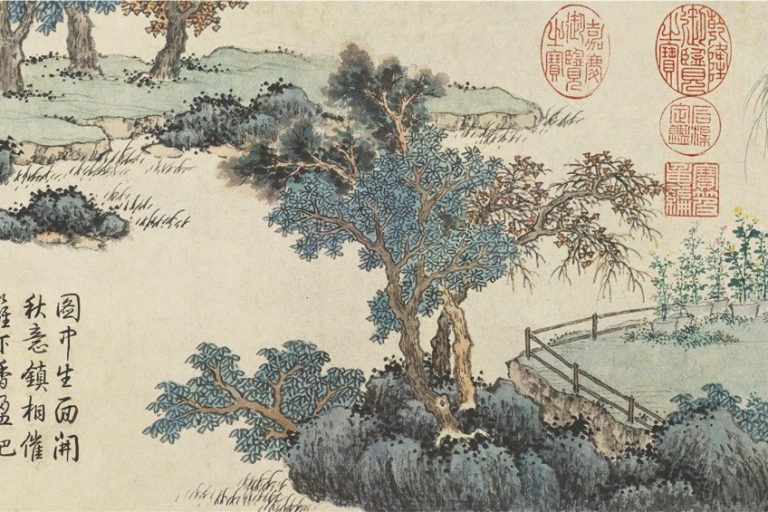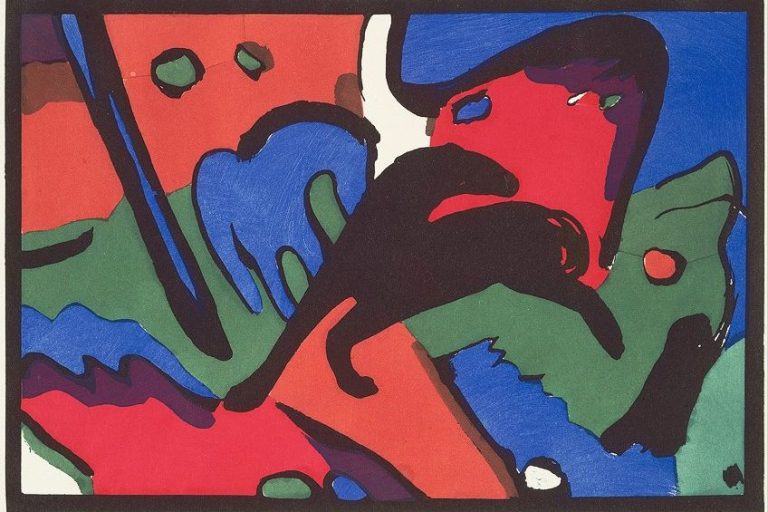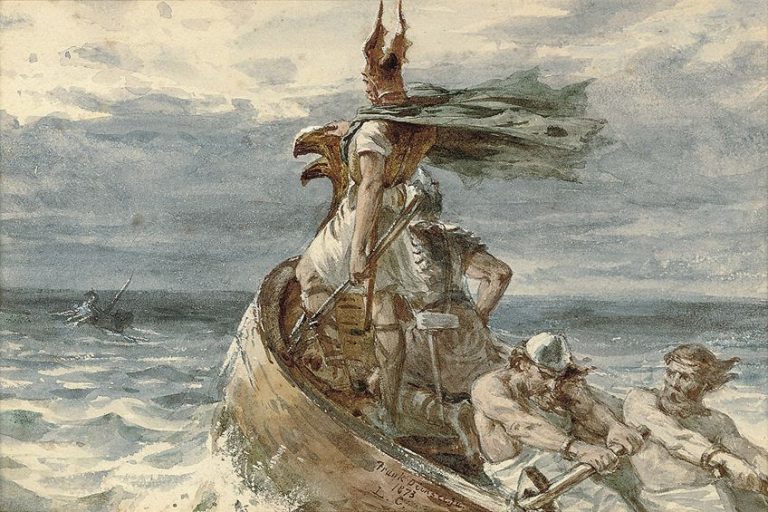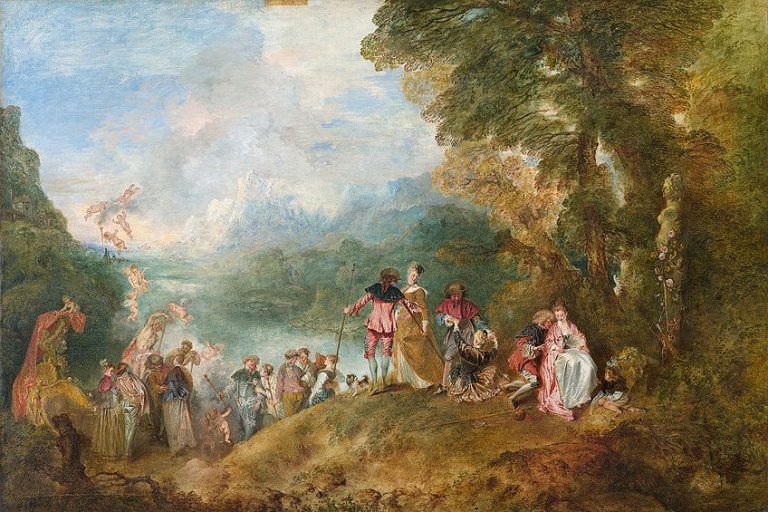Nihonga Art Movement – Timeless Japanese Art
The Nihonga art movement, emerging in Japan during the late 19th century, represents a pivotal fusion of traditional Japanese artistic techniques with modern influences. Rooted in the rich heritage of classical Japanese painting, Nihonga artists sought to preserve and reinvigorate indigenous aesthetics in the face of rapid Westernization. Utilizing natural pigments and materials such as silk and paper, these artists adhered to age-old practices while integrating innovative elements, thereby creating a unique and enduring visual language. The movement not only reaffirmed Japan’s cultural identity but also significantly impacted global perceptions of Japanese art, fostering a renewed appreciation for its depth and beauty.
Key Takeaways
- Nihonga emerged during the Meiji Period to preserve traditional Japanese art.
- It uses natural materials and traditional techniques distinct from Western art.
- Notable artists include Sakakibara and Kawai.
Origins and Historical Development
| Date Movement Started | 1882 |
|---|---|
| Date Movement Ended | Still ongoing |
| Prominent Members | Yokoyama Taikan, Hishida Shunsō, Takeuchi Seihō, Maeda Seison |
| Style of Work | Traditional Japanese painting techniques with modern themes, using materials such as washi paper, silk, sumi ink, and mineral pigments |
The Nihonga art movement emerged as a response to Japan’s rapid modernization during the Meiji Period. As Western influences began to permeate Japanese society, artists sought to preserve and celebrate traditional Japanese aesthetics and techniques. Nihonga, literally meaning “Japanese painting,” symbolizes this dedication to maintaining the cultural heritage while also incorporating select Western artistic methods. Nihonga encompasses a broad range of subjects, from the serene beauty of natural landscapes to intricate depictions of historical and cultural themes.
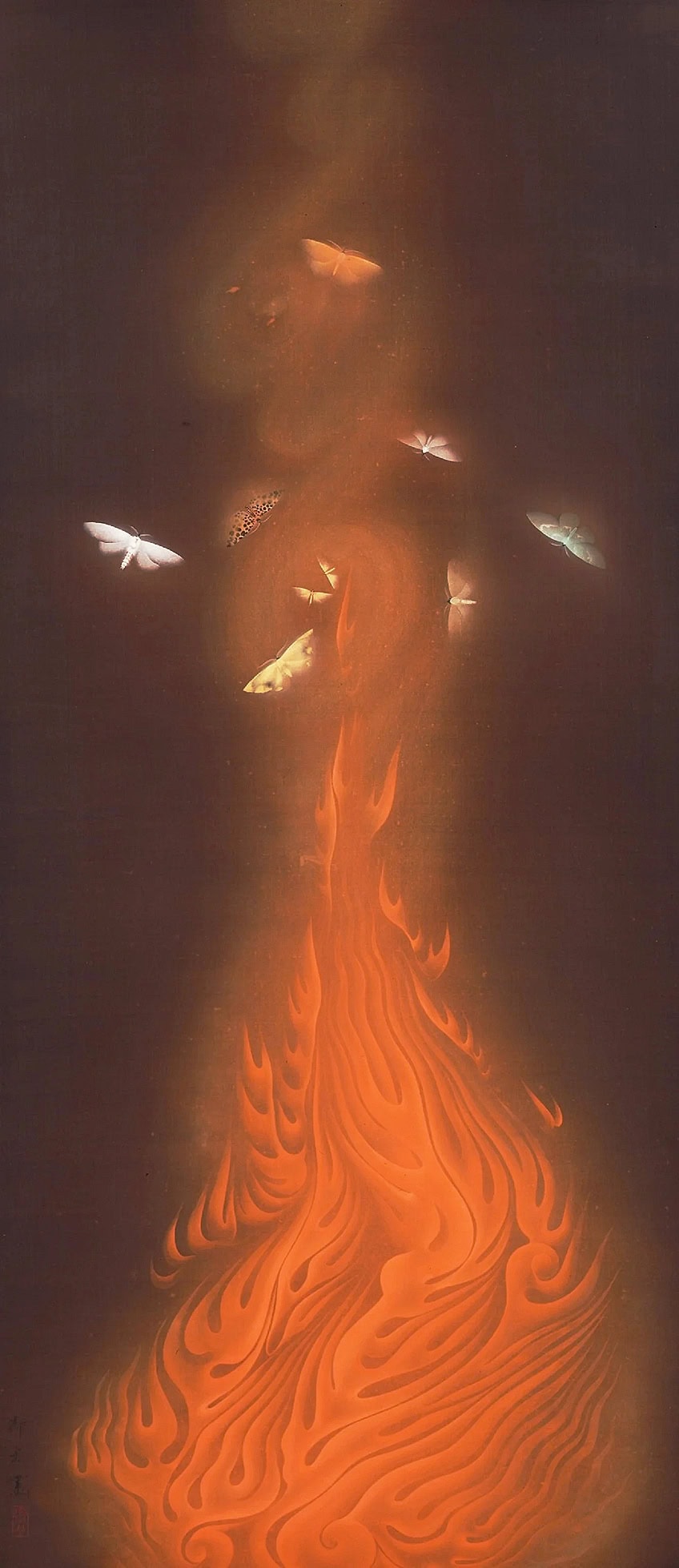
The movement is defined not just by its themes but by its distinctive use of natural materials like mineral pigments, ink, and traditional brushes. This approach sets Nihonga apart from Western-style oil painting, emphasizing a harmony with nature and a deep respect for Japanese artistic traditions. Among its notable contributors, artists such as Sakakibara and Kawai have left an indelible mark, with works like White Heron and Spring Drizzle capturing the essence of Nihonga’s aesthetic values.
Their contributions have ensured that the spirit and techniques of traditional Japanese painting continue to be relevant in modern art discourse.
Edo and Meiji Periods
During the Edo Period (1603 – 1868), traditional Japanese painting thrived, characterized by the use of natural pigments and ink on paper or silk. Artists focused on landscapes, nature, and historical subjects. The isolationist policies of the Tokugawa shogunate helped maintain these traditional art forms without much external influence.
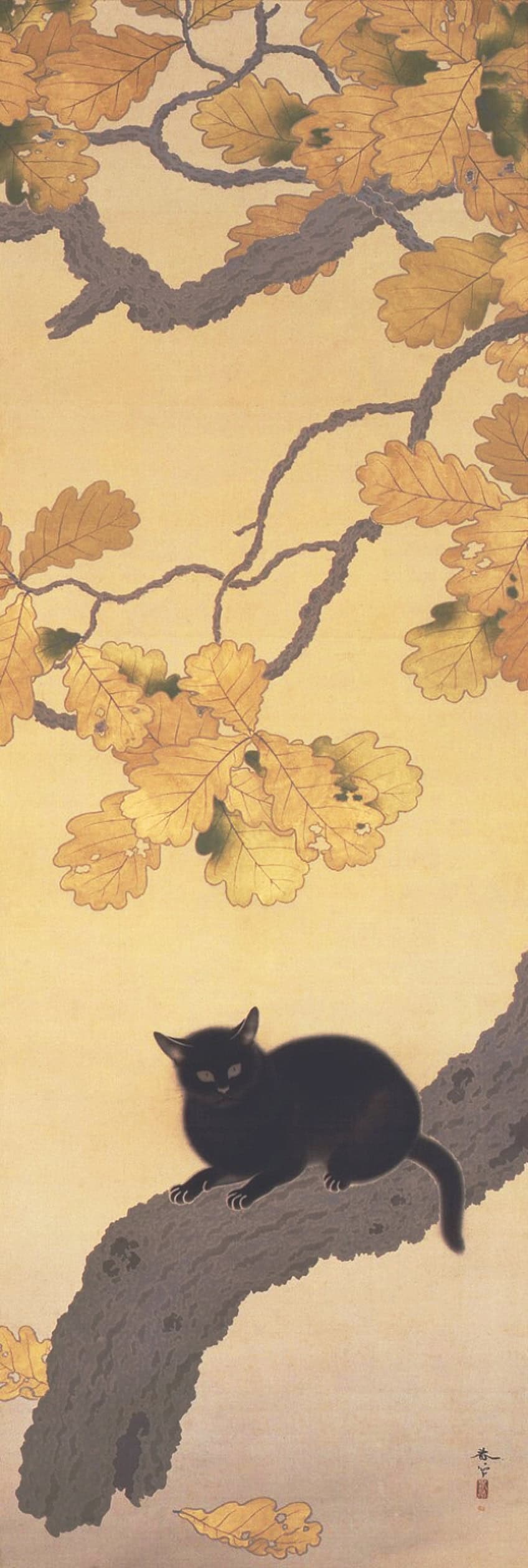
The Meiji Period (1868 – 1912) marked a significant shift. Japan opened its trade borders, leading to a rapid influx of Western ideas and technologies. This period of modernization threatened traditional Japanese arts. Nihonga was born out of a desire to safeguard and evolve these traditional techniques. The movement was formalized with the establishment of the Tokyo Fine Arts School in 1887, where artists aimed to merge the old and the new while retaining the core principles of Japanese aesthetics.
Influence of Western Art
The influence of Western painting (Yoga) became increasingly prominent in the Meiji Period. Western techniques, such as oil painting and perspective, began to permeate Japanese art. This was both a challenge and an opportunity for traditionalists. Some artists incorporated Western elements into their work, while others strictly adhered to traditional Japanese techniques to differentiate Nihonga from Western styles.
Okakura Kakuzo, also known as Okakura Tenshin, was a pivotal figure in this context.
He had a background in Western art but was a staunch advocate for preserving Japanese traditions. His efforts played a crucial role in defining and promoting the Nihonga movement, emphasizing the use of traditional materials like mineral pigments, ink, and silk.
Key Art Movements and Schools
The formation of art organizations and schools during the late 19th and early 20th centuries was essential for the development of Nihonga. The Tokyo Fine Arts School and other institutions became breeding grounds for innovation within the framework of traditional Japanese painting.

Nihonga artists often held exhibitions to showcase their work, allowing for the exchange of ideas and styles. The blending of different schools and the additional influence of Western techniques led to a rich, evolving art form. This period also saw Nihonga influencing and being influenced by other Asian art movements, most notably the Bengal School of Art in India, which shared a similar quest for modernity rooted in tradition.
Key Ideas and Concepts
Nihonga is rooted in traditional Japanese painting techniques and adopted mineral pigments and ink on silk or paper. It gained prominence through initiatives like The Painting Appreciation Society and saw the formation of collectives. Post-World War II, Nihonga evolved with contemporary influences.
Technique of Nihonga
Nihonga utilizes mineral pigments, derived from natural sources such as shells and stones, as well as plant-based pigments. These pigments are often mixed with animal hide glue. Materials include silk, paper, and occasionally canvas. The application of gold and silver leaf is a distinctive feature, creating a rich and brilliant effect.
Nihonga artists employ specific brushes and ladders to reach extended canvases, emphasizing precision and traditional aesthetics.
The Painting Appreciation Society (1884)
Ernest Fenollosa and Okakura Kakuzō founded the Painting Appreciation Society in 1884. Their aim was to revive and promote traditional Japanese arts. The society held exhibitions and lectures, reinforcing the value of Japanese artistic heritage. It played a significant role in distinguishing Nihonga from Western-style painting, Yōga. This proactive approach helped establish Nihonga as a respected genre within modern Japanese art.
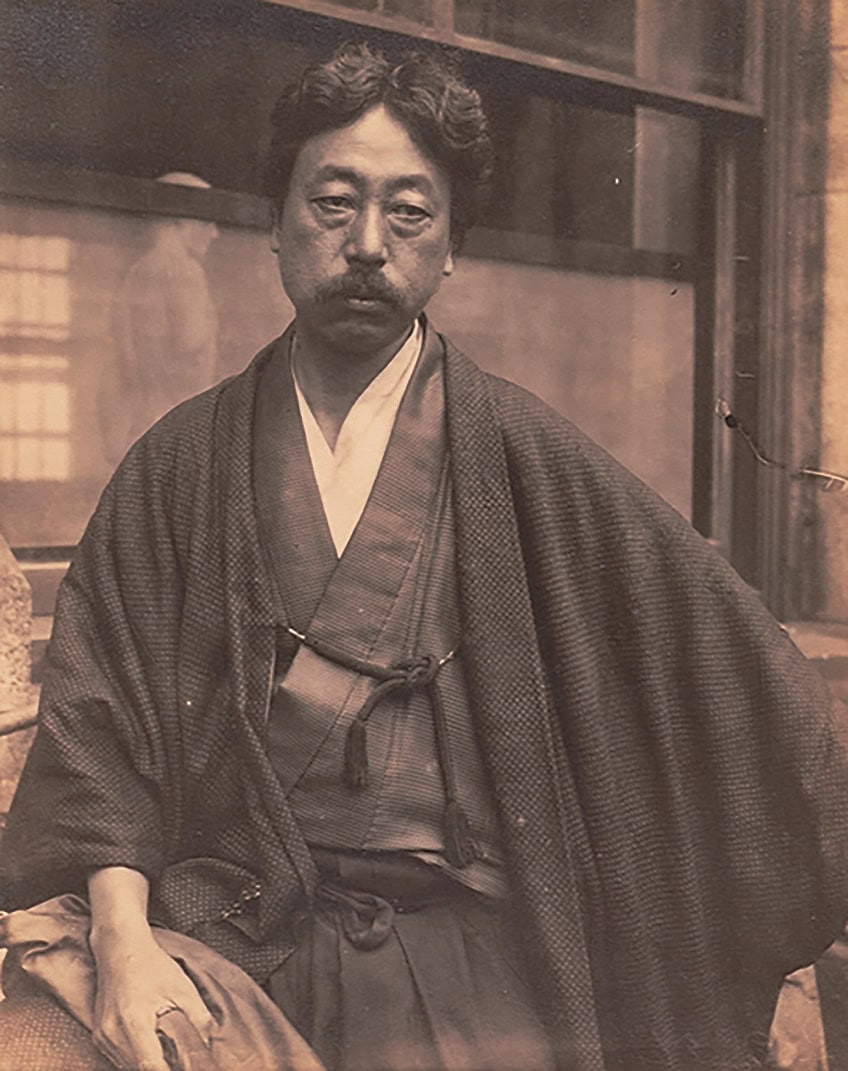
The Rise of Nihonga Collectives
During the Taishō and early Shōwa periods, artist collectives formed to foster collaboration and innovation in Nihonga. Groups like the Japan Artists’ Association were pivotal. These collectives provided forums for exhibitions, discussions, and shared resources. Collaboration led artists to explore new techniques and themes while maintaining traditional methods.
Such movements ensured the sustained development and relevance of Nihonga in a rapidly modernizing society.
Post-World War II
Post-World War II, Nihonga artists began integrating contemporary motifs and materials. Influences from Western art movements like Abstract Expressionism were evident. Acrylic paint and other modern materials became more common, though traditional methods remained crucial. This period marked a blending of old and new. While retaining its roots, Nihonga adapted to reflect the changing cultural landscape of Japan and the world.
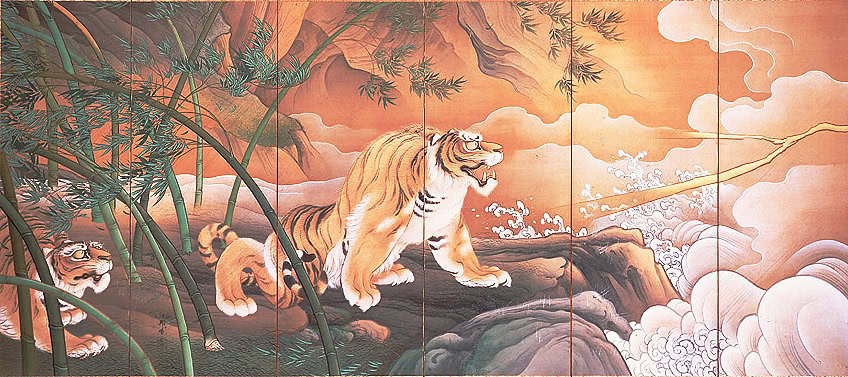
Artistic Techniques and Mediums
Nihonga, a traditional Japanese painting style, employs unique techniques and specific materials such as mineral pigments and washi paper, which set it apart from Western art.
Materials and Tools
Nihonga artists primarily use natural materials. Mineral pigments are a key component, derived from ground minerals and mixed with a natural glue called nikawa. These pigments produce vibrant, long-lasting colors. Sumi ink, made from soot and animal glue, is often employed for outlines and initial sketches. Washi paper and silk serve as the primary surfaces, chosen for their texture and durability. Gold and silver leaf are frequently applied, providing a reflective quality. Artists utilize brushes known as fude, crafted from animal hair, to achieve different textures and effects.
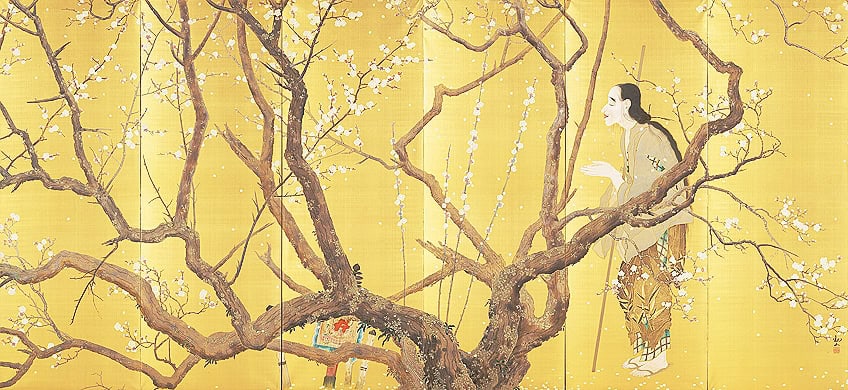
Stylistic Elements
Nihonga emphasizes subtlety and harmony. It avoids the realism often seen in Western art, favoring abstract and impressionistic techniques. The use of natural colors derived from minerals, plants, and shells imbues the artwork with a distinct palette. Line work, executed with sumi ink, is precise and intentional. The application of gold leaf and silver leaf adds visual depth and symbolism, often representing light or divine elements.
Artists aim for a balanced composition, where every color and line contributes to the whole.
Format and Composition
Nihonga artworks come in various formats, including hanging scrolls, folding screens, and panel paintings. Screens and panels allow for expansive compositions that can be viewed from multiple angles. The composition often follows traditional Japanese aesthetics, where empty space (referred to as ma) is as important as filled space. Themes from nature, seasonal changes, and historical events are common subjects. Placement and flow within the artwork are carefully considered to guide the viewer’s eye through the piece organically and thoughtfully.
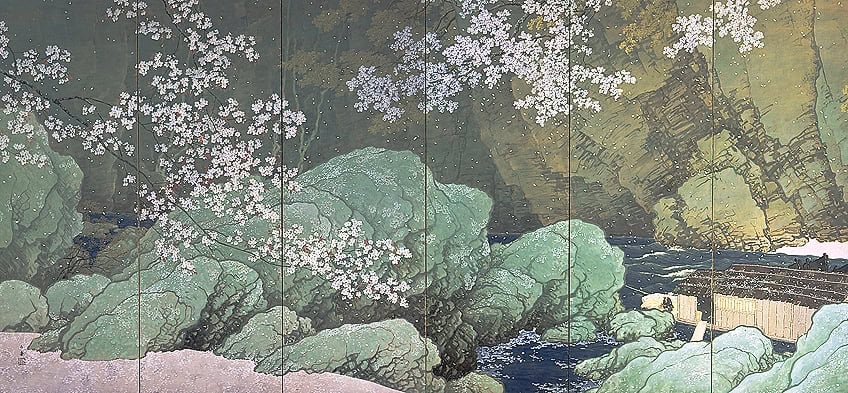
Notable Artists and Works
Notable artists of the Nihonga movement include pioneering figures such as Yokoyama Taikan and Shimomura Kanzan and contemporary artists like Hiroshi Senju and Takashi Murakami, who integrate traditional techniques with modern themes.
Pioneers of Nihonga
Yokoyama Taikan played a crucial role in the Nihonga movement with his innovative use of morotai, a technique blending colors to create atmospheric effects. His work emphasized traditional Japanese aesthetics while exploring new artistic expressions. Pieces like Metempsychosis display this blend of old and new.
Shimomura Kanzan is another notable figure whose works often incorporated rich, gold backgrounds.
This technique can be seen in The Beggar Monk, where gold contrasts dramatically with the subject, adding depth and brilliance. Kanzan’s contributions were pivotal in defining the Nihonga aesthetic and keeping it distinct from Western influences.
Contemporary Nihonga Artists
Hiroshi Senju is renowned for his majestic waterfall paintings, which masterfully merge traditional Nihonga techniques with a contemporary approach. The cascading waters in pieces like Cliff evoke a serene yet powerful emotional response, showcasing his expertise.
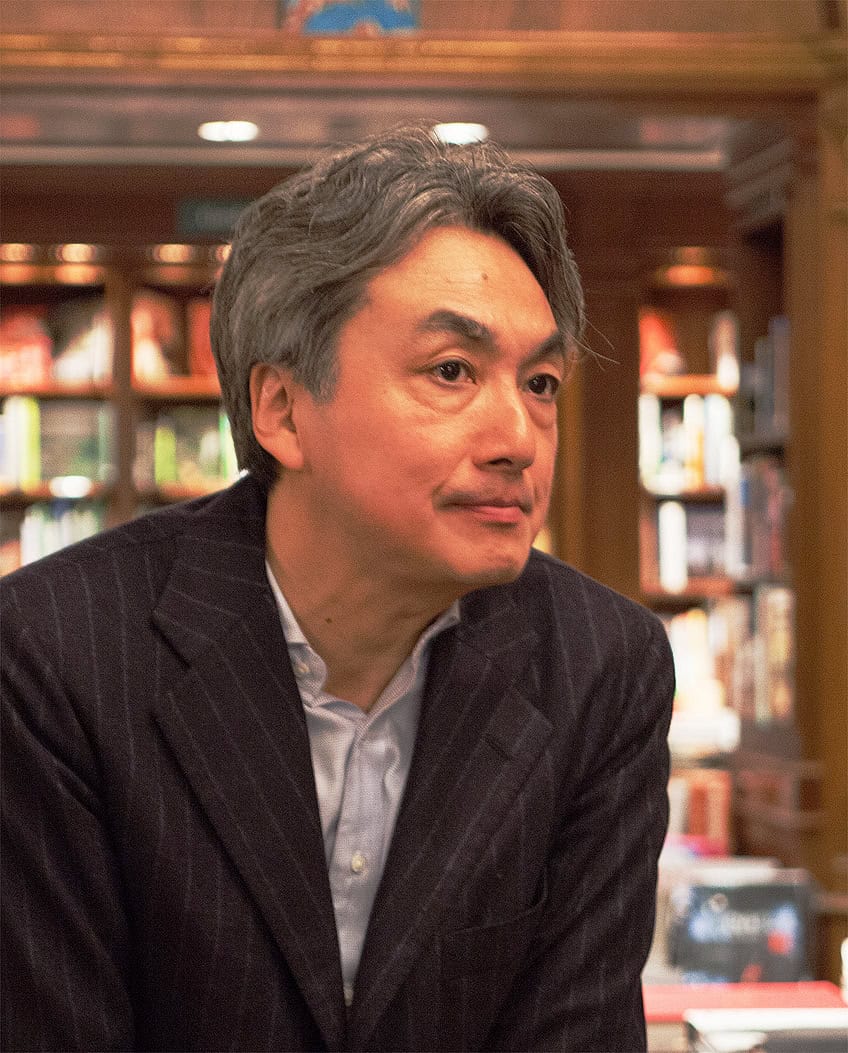
Takashi Murakami, though often associated with the Superflat movement, has roots in Nihonga. His works nod to traditional themes while incorporating vibrant, contemporary elements. Murakami’s ability to bridge historical and modern aspects of Japanese art places him as a significant contemporary figure within the Nihonga genre.
Both these contemporary artists contribute to the ongoing evolution of Nihonga, ensuring that it remains a dynamic and influential art form.
Cultural Impact and Modern Relevance
Nihonga, with its deep roots in Japanese traditions, continues to influence both modern art and cultural practices. Its reach extends globally, illuminating traditional aesthetics while adapting to contemporary tastes.
Global Exhibitions and Collections
Nihonga has been featured prominently in global exhibitions, showcasing its unique aesthetics to a wider audience. Institutions like the Pola Museum of Art often hold extensive exhibitions dedicated to Nihonga. In New York, galleries have presented works by Nihonga masters, enhancing its appeal and inspiring new art forms.
Major collections in Kyoto and other cities ensure the preservation and appreciation of Nihonga, highlighting both historical and contemporary pieces that continue to attract international attention.
Preservation of Tradition
A key aspect of Nihonga is its adherence to traditional Japanese art materials and techniques. Artists use silk, washi paper, and natural mineral pigments, which are also taught and preserved at institutions like the Tokyo Fine Arts School. Such practices help sustain the artistic heritage. Various art organizations and initiatives promote these traditional methods, ensuring that modern Nihonga artists remain connected to their historical roots while infusing their work with fresh perspectives.
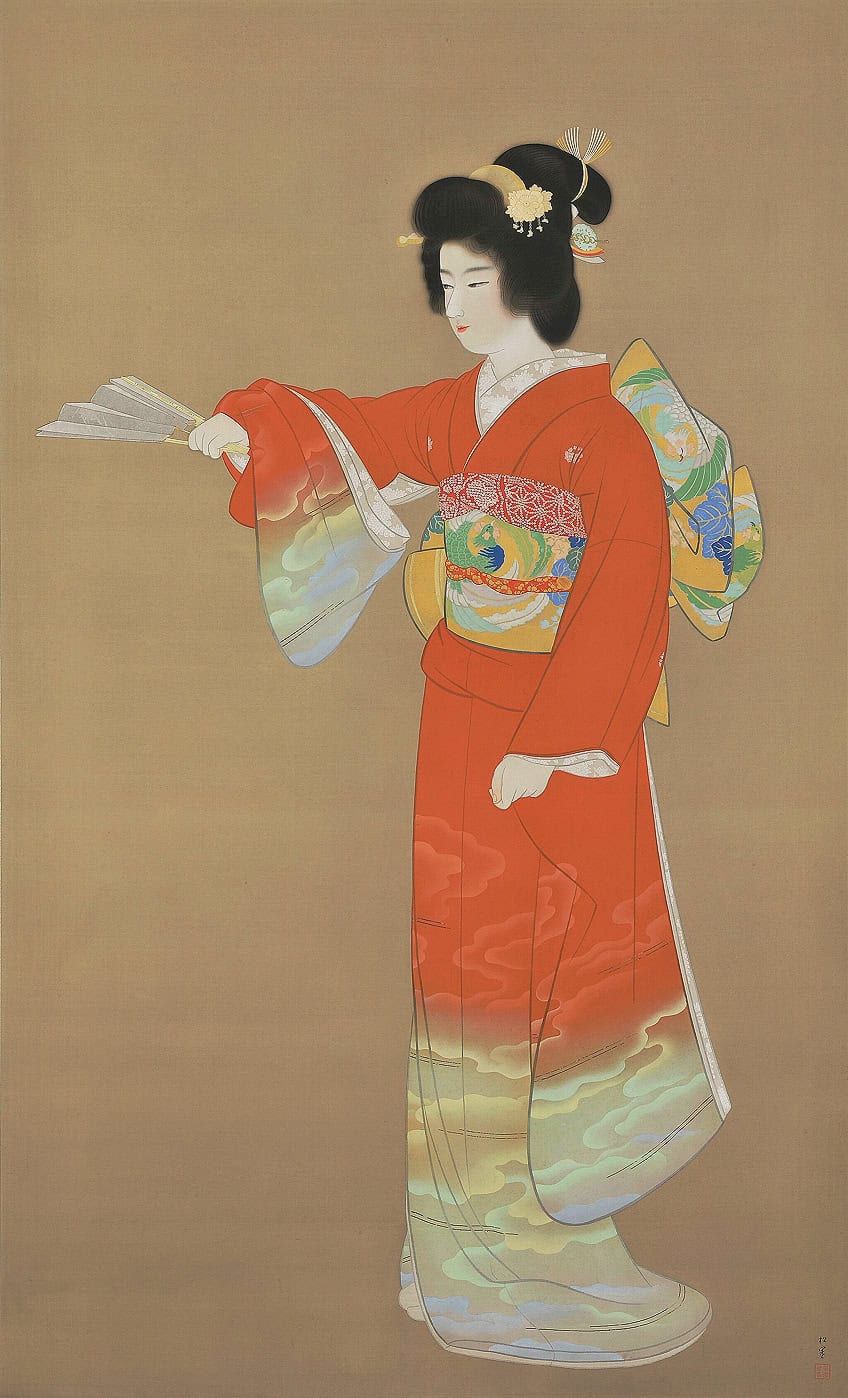
1980s Revival of Nihonga
The 1980s marked a significant revival of Nihonga. This period saw a renewed interest in traditional art forms, driven by both cultural nostalgia and a desire to counter the increasing influence of Western styles. Avant-garde movements within Nihonga also emerged, blending old techniques with new themes.
Exhibitions worldwide started focusing on landscape and historical motifs, renewing interest in the genre and leading to a resurgence in its popularity both in Japan and internationally.
Nihonga and Modern Japanese Culture
Contemporary Nihonga artists actively integrate elements of modern Japanese society into their work. Themes often include urban landscapes and contemporary issues, reflecting the evolving Japanese culture. The art form continues to be taught and practiced widely, maintaining its relevance. Artists and educators strive to keep Nihonga vibrant, ensuring that it resonates with younger generations. This blend of old and new underscores Nihonga’s enduring significance in today’s cultural milieu.
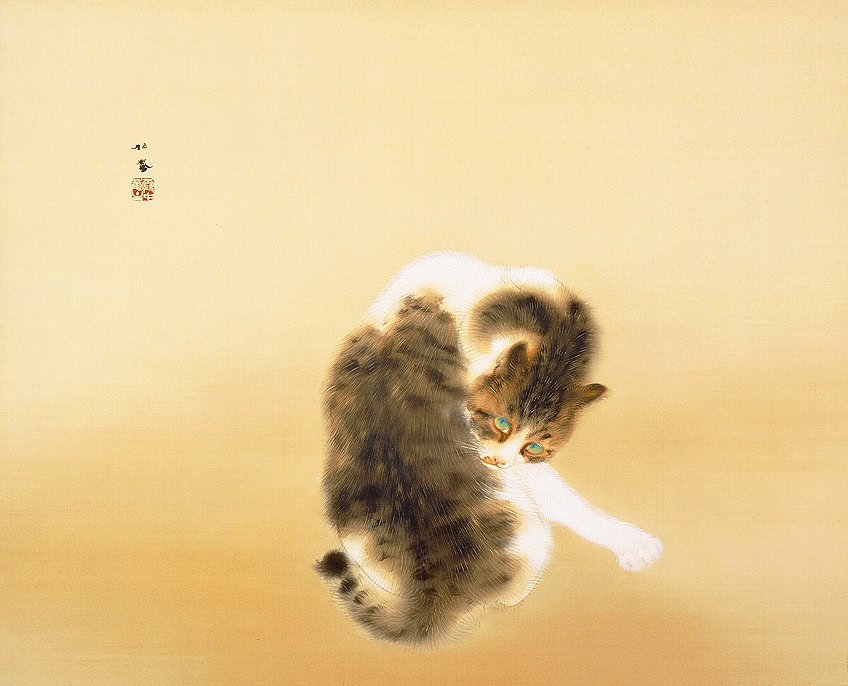
The Nihonga art movement stands as a testament to Japan’s ability to harmoniously blend tradition with innovation. By revitalizing classical techniques and materials within a modern context, Nihonga artists preserved the essence of Japanese cultural heritage while pushing the boundaries of artistic expression. This movement has not only reinforced the nation’s artistic identity but has also influenced contemporary art globally, showcasing the enduring relevance and adaptability of traditional Japanese art forms. As Nihonga continues to inspire and evolve, it remains a vital and dynamic force within the world of art, bridging the past and present with its timeless beauty and profound cultural significance.
Frequently Asked Questions
Who Are Some Notable Artists Associated With the Nihonga Movement?
Some well-known artists in the Nihonga movement include Yokoyama Taikan, Hishida Shunsō, and Uemura Shōen. These artists were instrumental in defining and evolving the style, each bringing their unique perspectives and innovations.
What Historical Developments Led to the Formation of the Nihonga Art Movement?
Nihonga emerged during the Meiji Period as Japan opened its trade borders after over two centuries of isolation. The influx of Western influence and modernization efforts prompted Japanese artists to preserve their cultural heritage while engaging with new artistic ideas. This period of cultural transition was pivotal in the formation of the Nihonga movement.
How Does Nihonga Distinguish Itself in Terms of Technique and Materials Used?
Nihonga employs traditional Japanese techniques and materials such as washi paper, silk, and natural pigments derived from minerals and plants. The methods emphasize brushwork, meticulous layering, and a focus on texture, which contrast with Western styles that often prioritize realism and perspective.
What Does the Term, Nihonga, Signify Within the Context of Japanese Art?
Nihonga literally means Japanese painting. Coined by American professor Ernest Fenollosa in 1882, the term differentiates traditional Japanese art from Western-style paintings. It underscores a commitment to Japanese artistic heritage and distinct methodologies.
Isabella studied at the University of Cape Town in South Africa and graduated with a Bachelor of Arts majoring in English Literature & Language and Psychology. Throughout her undergraduate years, she took Art History as an additional subject and absolutely loved it. Building on from her art history knowledge that began in high school, art has always been a particular area of fascination for her. From learning about artworks previously unknown to her, or sharpening her existing understanding of specific works, the ability to continue learning within this interesting sphere excites her greatly.
Her focal points of interest in art history encompass profiling specific artists and art movements, as it is these areas where she is able to really dig deep into the rich narrative of the art world. Additionally, she particularly enjoys exploring the different artistic styles of the 20th century, as well as the important impact that female artists have had on the development of art history.
Learn more about Isabella Meyer and the Art in Context Team.
Cite this Article
Isabella, Meyer, “Nihonga Art Movement – Timeless Japanese Art.” Art in Context. July 3, 2024. URL: https://artincontext.org/nihonga-art-movement/
Meyer, I. (2024, 3 July). Nihonga Art Movement – Timeless Japanese Art. Art in Context. https://artincontext.org/nihonga-art-movement/
Meyer, Isabella. “Nihonga Art Movement – Timeless Japanese Art.” Art in Context, July 3, 2024. https://artincontext.org/nihonga-art-movement/.


